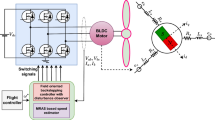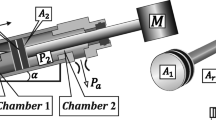Abstract
This work presents an integrated pressure-tracking controller for a novel electro-hydraulic brake (EHB) system considering friction and hydraulic disturbances. To this end, a mathematical model of an EHB system, consisting of actuator and hydraulic sub-systems, is derived for describing the fundamental dynamics of the system and designing the controller. Due to sensor inaccuracy and measurement noise, a Kalman filter is constructed to estimate push rod stroke for generating desired master cylinder pressure. To improve pressure-tracking accuracy, a linear friction model is generated by linearizing the nonlinear Tustin friction model, and the unmodeled friction disturbances are assumed unknown but bounded. A sliding mode controller is designed for compensating friction disturbances, and the stability of the controller is investigated using the Lyapunov method. The performance of the proposed integrated controller is evaluated with a hardware-in-the-loop (HIL) test platform equipped with the EHB prototype. The test results demonstrate that the EHB system with the proposed integrated controller not only achieves good pressure-tracking performance, but also maintains robustness to friction disturbances.
Similar content being viewed by others
References
RAO Zhong-hao, HUO Yu-tao, LIU Xin-jian. Experimental study of an OHP-cooled thermal management system for electric vehicle power battery [J]. Experimental Thermal and Fluid Science, 2014, 57: 20–26.
LIU Yan-fang, DAI Zhen-kun, XU Xiang-yang, TIAN Liang. Multi-domain modeling and simulation of proportional solenoid valve [J]. Journal of Central South University of Technology, 2011, 18(5): 1589–1594.
GAO Y, EHSANI M. Electronic braking system of EV and HEV - integration of regenerative braking, automatic braking force control and ABS [C]// 2001 SAE World Congress. Detroit, Michigan: SAE, 2001: 5–8.
PETER C, FRANCZISKA B, THOMAS F. Energy recapture through deceleration-regenerative braking in electric vehicles from a user perspective [J]. Ergonomics, 2013, 56(8): 1203–1215.
LV Chen, ZHANG Jun-zhi, LI Yu-tong. Extended-Kalman-filterbased regenerative and friction blended braking control for electric equipped with axle motor considering damping and elastic properties of electric powertrain [J]. Vehicle System Dynamics, 2014, 52(11): 1372–1388.
FENG Chong, DING Neng-gen, HE Yong-ling, XU Guo-yan, GAO Feng. Control allocation algorithm for over-actuated electric vehicles [J]. Journal of Central South University, 2014, 21(10): 3705–3712.
KO J W, KO S Y, KIM I S. Co-operative control for regenerative braking and friction braking to increase energy recovery without wheel lock [J]. International Journal of Automotive Technology, 2014, 15(2): 253–262.
LIAN Yu-feng, TIAN Yan-tao, HU Lei-lei. A new braking force distribution strategy for electric vehicle based on regenerative braking strength continuity [J]. Journal of Central South University, 2013, 20(12): 3481–3489.
CASTRO D C, TODESCHINI F, ARAUJO R E, SAVARESI S M, CORNO M, FREITAS D. Adaptive-robust friction compensation in a hybrid brake-by-wire actuator [J]. Proceedings of the Institution of Mechanical Engineers, Part I: Journal of Systems and Control Engineering, 2014, 228(10): 769–786.
LI Yi-bo, PAN Qing, HUANG Ming-hui. Model-based parameter identification of comprehensive friction behaviors for giant forging press [J]. Journal of Central South University, 2013, 20(9): 2359–2365.
YANG Xia-wei, LI Wen-ya, MA Tie-jun. Computational analysis of linear friction welding process and micromechanical modeling of deformation behavior for medium carbon steel [J]. Journal of Central South University, 2015, 22(9): 2359–2365.
ARMSTRONG H B, DUPONT P, CANUDAS D W C. A survey of models, analysis tools and compensation methods for the control of machines with friction [J]. Automatica, 1994, 30(7): 1083–1138.
FEEMSTER M, VEDAGARBHA P, DAWSON D M, HASTE D. Adaptive control techniques for friction compensation [J]. Mechatraonics, 1999, 9(2): 125–145.
CANUDAS D W C, OLSSON H, ASTROM K J, LISCHINSKY P. A new model for control of systems with friction [J]. IEEE Transactions on Automatic Control, 1995, 40(3): 419–425.
MARTON L, FODOR S, SEPEHRI N. A practical method for friction identification in hydraulic actuators [J]. Mechatronics, 2011, 21(1): 350–356.
MERRITT H E. Hydraulic control systems [M]. London: Wiley, 1967.
BIGRAS P. Reduced nonlinear observer for bounded estimation of the static friction model with Stribeck effect [J]. System & Control Letters, 2009, 58(2): 119–123.
RAMEZANI M, RIPIN Z M, AHMAD R. Modelling of kinetic friction in V-bending of ultra-high-strength steel sheets [J]. The International Journal of Advanced Manufacturing Technology, 2010, 46(1): 101–110.
HUA Chun-li, RAO Zhu-shi, TA Na, ZHU Zhen-cai. Nonlinear dynamics of rub-impact on a rotor-rubber bearing system with the Stribeck friction model [J]. Journal of Mechanical Science and Technology, 2015, 29(8): 3109–3119.
TUSTIN A. The effects of backlash and of speed-dependent friction on the stability of closed-cycle control system [J]. The Journal of Institution of Electrical Engineers, 1947, 94(2): 143–151.
BROOKNER E. Tracking and Kalman filtering made easy [M]. London: Wiley & Sons, 1998.
GREWAL M S, ANDREWS A P. Kalman filtering: Theory and practice [M]. New Jersey: Prentice-Hall, 1993.
VADIM I U. Nonlinear and optimal control theory [M]. Berlin: Springer, 2008.
DING X, MIKARIC S, HE Y. Design of an active trailer-steering system for multi-trailer articulated heavy vehicles using real-time simulations [J]. Proceedings of the Institution of Mechanical Engineers, Part D: Journal of Automobile Engineering, 2012, 227(5): 643–655.
WANG Q, HE Y. Design and validation of active trailer steering systems for multi-trailer articulated heavy vehicles considering driver-vehicle-controller interactions [J]. International Journal of Vehicle Performance, 2015, 2(1): 58–84.
OHTANI Y, INNAMI T, OBATA T, YAMAGUCHI T. Development of an electrically-driven intelligent brake unit [C]// 2011 SAE World Congress. Detroit, Michigan: SAE, 2011: 12–14.
Author information
Authors and Affiliations
Corresponding author
Additional information
Foundation item: Projects(51405008, 51175015) supported by the National Natural Science Foundation of China; Project(2012AA110904) supported by the National High Technology Research and Development Program of China
Rights and permissions
About this article
Cite this article
Yong, Jw., Gao, F., Ding, Ng. et al. Pressure-tracking control of a novel electro-hydraulic braking system considering friction compensation. J. Cent. South Univ. 24, 1909–1921 (2017). https://doi.org/10.1007/s11771-017-3598-2
Received:
Accepted:
Published:
Issue Date:
DOI: https://doi.org/10.1007/s11771-017-3598-2




